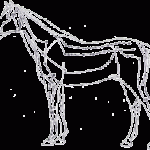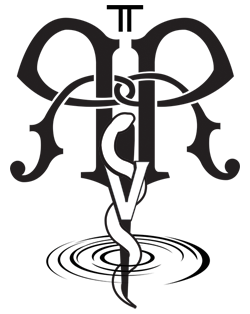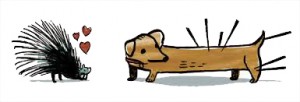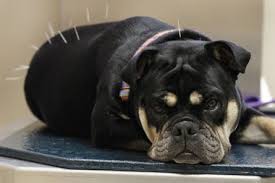Veterinary Acupuncture
Acupuncture is a system of medical treatment that is some 4,000 years old. It was developed in China and is based upon an ancient understanding of the flow of electrical energy through the body. This energy is called Chi or Qi. The ancients traced and described the meriduans through which Chi flows; located points where changes could be made; and discussed diseases—not in western terms—but as imbalances in the five elements that affect the body: fire, earth, metal, water, and wood. A diagnosis was made by examining the pulses, looking at the patient especially his tongue, taking a detailed history, and then relating these findings to the elements. Points were selected to treat the imbalances and pierced with an ever advancing series of pointed objects starting with stones, progressing through sharpened sticks and metal rods, to the very modern stainless steel needles. This modality of treatment was so successful that it spread through the Eastern countries via the trade routes. Today, Acupuncture is still the primary source of medical treatment in many parts of the world.It wasn’t until 1972 when Nixon went to China that Acupuncture was introduced to the United States. He and his entourage of American doctors visited the Chinese hospitals in which surgeries were conducted using only acupuncture for anesthesia; and to clinics where diseases and injuries were being healed with acupuncture and herbs. American doctors were shocked but impressed by these sights and case histories. For several months medical journals, television, and the popular press expounded upon Acupuncture. Very shortly, veterinarians began to question whether it would “work” on animals. At UCLA, the earliest studies of Acupuncture involving animals were done to prove that Acupuncture worked on humans. If it worked on animals, it was thought that the cures and anesthesia effects attributed to acupuncture could not be due to hypnosis or some other form of mental suggestion.
Interested veterinarians began to seek knowledge about acupuncture for a very different reason. Could animals be successfully treated using Acupuncture? In 1973 Nancy Evans was engaged by Accu Tube Corp. in Englewood Colorado to design and conduct a research project to determine just that. They were retooling their equipment to provide needles and stimulation devices to support the treatment of human patients. If they could include veterinarians as their customers, this would be financially advantageous. Accu Tube Corp. began advertising needles in veterinary publications, and they became a clearing house for the dissemination of information to veterinarians who were trying to answer this question. Nancy explored the modality, mentored by two ex-servicemen who had learned acupuncture in Japan. She began to examine and treat animals, mostly horses. Acupuncture seemed safe and it worked very well. As more information came out of China, she incorporated that into her treatment knowledge, but at this point, no information indicated that it was being used on animals. 
In 1974, UCLA hosted a meeting for veterinarians interested in learning more about acupuncture for animals. Nancy Evans was invited and attended along with about 200 others. By today’s standards, little was known about acupuncture in general and acupuncture for animals in general. But it was obvious that veterinarians were interested and friendships and working relationships resulted. Meeting and working with the UCLA group resulted in Evans’ decision to move to California to work with Alice De Groot, DVM. It was here that she learned of the early animal chart of a horse which consisted of seven points. “Treat here for heart problems, there for liver problems, another place for digestive issues,” was indicated in in Chinese characters. Later, working with Dr. San Huck Shin, she was introduced to charts and models which had hundreds of points for hundreds of uses, but they were not organized into meridians. The charts were primarily for horses, but some were for camels, oxen, sheep, pigs, even fowl. None were for dogs and cats. Dogs and cats, even today, have little economic value in the orient.
Those of us who were studying animal acupuncture in the United States, became very frustrated with the single point approach, and began developing meridian charts for dogs and cats and horses so that we could apply what we were learning about meridians, diagnosis, and treatment protocols from the human literature. This was done using comparative anatomy coupled with hours of trial, error, and verification. It soon became obvious that animals and humans were very similar and the points worked quite predictably. Differences in basic anatomy were the biggest stumbling blocks and alternate points were discovered that functioned in a similar manner. (I.e. horses have a single toe while humans have five – this makes a big difference.) .
A system of treating animals was developing slowly, and still continues to be defined and refined. Veterinary Acupuncture, in fact all of acupuncture, today is leaps and bounds ahead of what we were discovering in the 1970’s, but new information is being learned today through research conducted throughout the world.
It was revealed to me much later by my Chinese mentor that the Chinese believe that animals have no souls and therefore can have no meridians. They just treat them differently. Even today, most human practitioners of acupuncture will say that they cannot treat an animal.
Here at Red Rowan Acupuncture has been found to be a powerful adjunct to Chiropractic in the treatment of orthopedic conditions. These range from a simple sore back, through a variety of lameness, to controlling the pain of arthritis, hip or shoulder dysplasia, and bone cancer. Acupuncture has an extinguishing effect upon pain and upon the nausea and other digestive problems associated with cancer, radiation, and chemotherapy. Skin diseases and neurologic conditions are often dramatically altered and reversed with acupuncture, as are many nervous problems and digestive disturbances. Palliative and/or sustaining responses are often the effects of acupuncture on the aging and other degenerative processes. The manipulation of energy seems to move energy to where there is none, and control energy that has gone awry. We use it to improve quality of life and functionality.
THE ACUPUNCTURE APPOINTMENT
Nancy Evans, Dr. Bamford’s mother, was one of the pioneers in Veterinary Acupuncture. She studied with the National Association of Veterinary Acupuncture (NAVA) at UCLA and in Chino in the 1970’s, and has practiced veterinary acupuncture and physical therapy for many veterinarians since that time. She participated in many of the early studies and in the development of meridian charts for horses.
The laws of the state of California require that all acupuncture treatments of animals shall be performed by or under the supervision of a licensed veterinarian. In keeping with this requirement, all animals treated on these premises must be patients of Dr. Bamford’s or referred by another licensed veterinarian for acupuncture treatment. The initial Acupuncture appointment (except referrals) will include a physical examination by Dr. Bamford to determine if acupuncture is indicated as well as the Acupuncture evaluation and treatment. Subsequent treatments will not require a physical examination.
Follow-up Acupuncture appointments will be recommended according to the findings of the initial examination, as well as the response to that treatment. In very critical cases three times a week might be recommended. A usual protocol begins with acupuncture once a week for four weeks, reduced to once every two weeks; then once a month until a balance has been achieved that can be maintained by the body with occasional “tune-ups.”
Bodies—human or animal—are a system of balance.
When there is balance, there is ease. When there is imbalance, there is disease.



